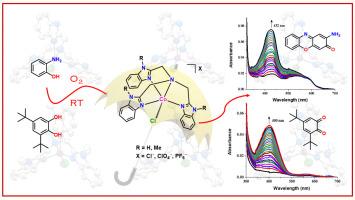Design and reactivity of Tripodal Tetradentate mononuclear cobalt(II) complexes as biomimetic models for Phenoxazinone synthase and Catecholase activity
IF 5.4
3区 化学
Q1 CHEMISTRY, INORGANIC & NUCLEAR
引用次数: 0
Abstract
On a quest to understand the effect of structural modification implied within outer coordination sphere, six mononuclear pentacoordinate cobalt complexes having the molecular framework [CoII(Ln)Cl]X {L1: tris((1H-benzo[d]imidazol-2-yl)methyl)amine; n = 1 and L2: tris(N-methylbenzimidazol-2-ylmethyl)amine; n = 2 and X = Cl−, ClO4−, PF6−} were synthesized and tested for their catalytic activity towards o-aminophenol (OAP) and 3,5-di-tert-butyl catechol (3,5-DTBC) oxidation. For OAP oxidations, the kcat values were 54.73 h−1 for [1]Cl and 58.67 h−1 for [2]Cl, while for catechol oxidation (CO), the values were 410.4 h−1 and 483.09 h−1, respectively. [1]ClO4 and [1]PF6 displayed less activity compared to the Cl− counterpart due to change in outer coordination sphere. The complexes with methylated ligand (L2) displayed enhanced catalytic activity, with the chloride-containing complex remaining the most effective overall. The change in redox behaviour of [1]Cl and [2]Cl have been observed upon successive addition of OAP and 3,5-DTBC, and the progression was closely monitored over time using cyclic voltammetry (CV). Furthermore, the formation of free radical intermediates was revealed from EPR investigation. The formation of adducts, reaction intermediates, and the involvement of molecular oxygen likely play key roles in these oxidation reactions, as strongly supported by mass spectrometric analysis.

三足四齿单核钴(II)配合物的设计和反应性作为苯恶嗪酮合成酶和儿茶酚酶活性的仿生模型
为了了解外配位球内结构修饰的影响,六个具有分子框架[CoII(Ln)Cl]X {L1:三((1h -苯并[d]咪唑-2-基)甲基)胺的单核五配位钴配合物;n = 1, L2:三(n -甲基苯并咪唑-2-甲基)胺;合成了n = 2和X = Cl−,ClO4−,PF6−},并测试了它们对邻氨基酚(OAP)和3,5-二叔丁基儿茶酚(3,5- dtbc)氧化的催化活性。对于OAP氧化,[1]Cl的kcat值为54.73 h−1,[2]Cl的kcat值为58.67 h−1,而儿茶酚氧化(CO)的kcat值分别为410.4 h−1和483.09 h−1。[1]ClO4和[1]PF6由于外配位球的改变而表现出较低的活性。甲基化配体(L2)配合物表现出较强的催化活性,含氯配合物总体上仍是最有效的。在连续添加OAP和3,5- dtbc后,观察到[1]Cl和[2]Cl氧化还原行为的变化,并使用循环伏安法(CV)密切监测其进展。此外,EPR研究还揭示了自由基中间体的形成。加合物、反应中间体的形成和分子氧的参与可能在这些氧化反应中起关键作用,质谱分析有力地支持了这一点。
本文章由计算机程序翻译,如有差异,请以英文原文为准。
求助全文
约1分钟内获得全文
求助全文
来源期刊

Inorganic Chemistry Communications
化学-无机化学与核化学
CiteScore
5.50
自引率
7.90%
发文量
1013
审稿时长
53 days
期刊介绍:
Launched in January 1998, Inorganic Chemistry Communications is an international journal dedicated to the rapid publication of short communications in the major areas of inorganic, organometallic and supramolecular chemistry. Topics include synthetic and reaction chemistry, kinetics and mechanisms of reactions, bioinorganic chemistry, photochemistry and the use of metal and organometallic compounds in stoichiometric and catalytic synthesis or organic compounds.
 求助内容:
求助内容: 应助结果提醒方式:
应助结果提醒方式:


